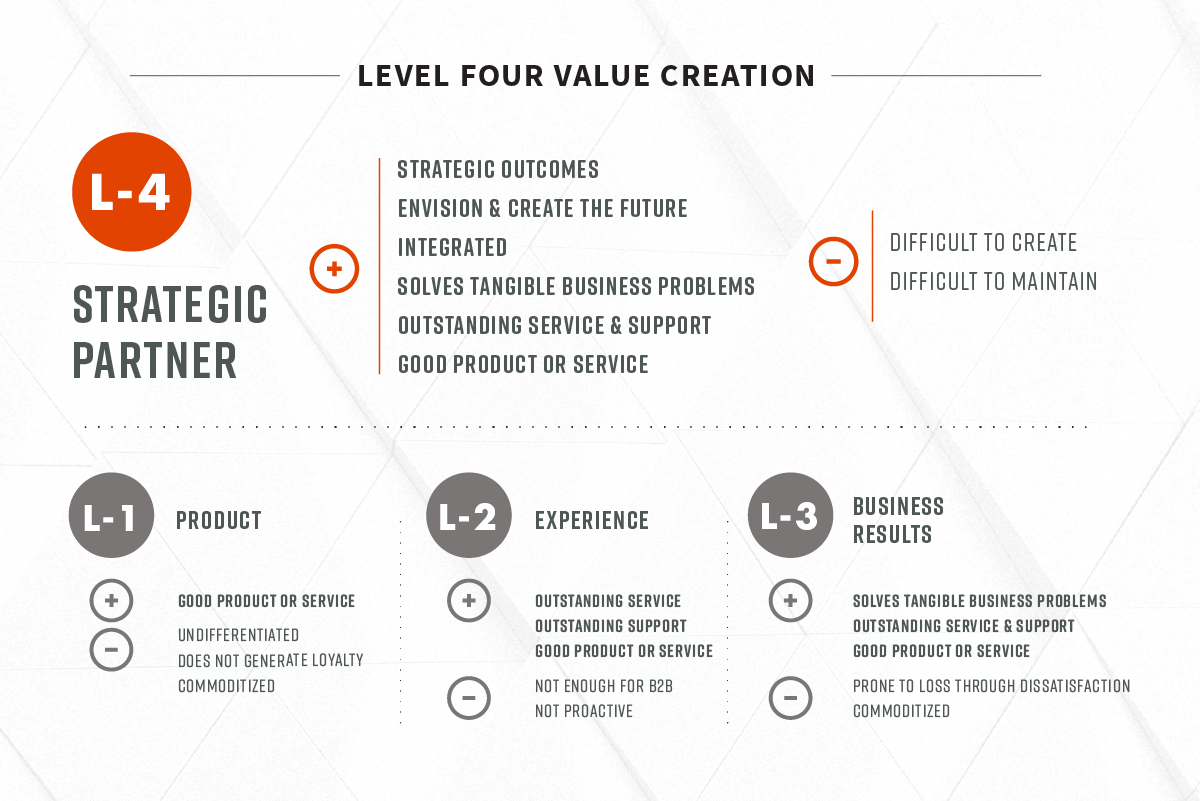To understand how to talk about your features and benefits, you must start by identifying the level of value the stakeholder needs from you. Not every stakeholder has the same interest in your features and benefits. End users will be disappointed if you decide not to share the features and benefits with them, but if you get too detailed about the day-to-day uses, you will alienate your higher-level contacts. To better understand which stakeholders need what conversations, we use a concept called Level 4 Value Creation™.
Very few salespeople are aware of the different levels of value and how they should guide sales conversations. Instead, they take a one-size-fits-all approach to sales. By trying to converse with people of all roles, titles, and levels at the same time, salespeople are likely to have the wrong conversation with most of them. This is especially true regarding features and benefits.

End Users
Most salespeople receive some kind of features and benefits training. Typically, this includes a relatively detailed explanation of features and benefits, including a demonstration. This level of discussion is designed for end users, who will care deeply about features and benefits. This is the lowest level of value (Level 1 Value Creation), but it is still critically important to the people who will wind up using what you sell.
This type of conversation gets salespeople in trouble because other stakeholders and decision-makers must sit patiently through a recitation of every feature and benefit the end users will enjoy. For example, most senior leaders avoid demonstrations of SAAS solutions because they will never use the software themselves. Too much detail about features and benefits can bore leaders out of the room as they promise themselves they'll never again join a demo.
Ancillary Stakeholders
Ancillary stakeholders are people who will have to work with you and your company, but they won’t directly use your product. This can include people who work in information technology, accounting, or some other department. While they won't use what you sell them, they have needs you must address. Ancillary stakeholders don’t care about the same things as end users. Instead, what is important to them is the next level of value (Level 2 Value Creation).
When salespeople share information about the features and benefits with this group, they should focus on the ease of doing business. For example, the information technology folks may need you to meet some security standards or technical spec to access your client’s servers. The accounting people may need custom invoices or reporting. These Level 2 features and benefits relate to the idea that you are "easy to do business with."
End users and management will care little about what these ancillary stakeholders need, and sales training should reflect that.
Management Stakeholders
Management stakeholders are interested in what we call Level 3 Value Creation. This means the conversation is about your ability to produce the tangible outcome promised by your product or service. Let's imagine you sell software that helps distribution companies pick and ship orders to consumers. The management stakeholders will want to know how your software will ensure their shipments leave on time and show up on the right porches.
At this level, a discussion of features and benefits includes how your software enables the company to take care of their shipments. After all, this is the primary outcome a shipping company buying your software would be interested in. There may be a couple of super users who care about end-user concerns, but most of your management-level stakeholders will not be interested in the software's features and benefits. They want to know that it works and can deliver the results they need.
Senior Leaders and Decision Makers
So here is where we are now: We have shown the end users the features and benefits that thrilled them, so they want to buy what you sell. We've explained to the ancillary stakeholders how the features and benefits we offer will make us easy to do business with, gaining their support. The manager has seen the features and benefits that ensure what you sell will work for them. This leaves us with the senior leader's needs.
If your goal is to frustrate and alienate a senior leader, ask them to sit through a conversation about a product's features and benefits. Leaders need a strategic level of value (Level 4 Value Creation). When a salesperson doesn't know what the decision-maker considers to be the ultimate benefit, they will have a conversation about the wrong thing, losing the leader's attention. A leader will leave the meeting once enough of their time has been wasted.
A senior leader wants you to deliver one thing, a strategic outcome. They don't want to buy software or some other product, regardless of how easy it is to use or how seamlessly it will integrate into existing systems. They want to buy a greater certainty that they will meet their service-level agreements with their clients. They want greater productivity that lowers their cost structure and provides them with an advantage. They want a platform that allows them to increase their footprint and take care of larger clients. To address this, a salesperson must have a conversation at a different level.
The New Features and Benefits Sales Training
No matter a stakeholder’s level, the person sitting across from you will have their own view of what constitutes a feature or a benefit. We have moved away from training features and benefits because there are often people in the room that don't care about them on a granular level. Any training on features and benefits should start by helping salespeople understand who is in the room and what they need from the conversation.
When you notice you have a senior leader in the room, you can remove them in one of two ways. The first way is to explain the features and benefits your product provides to end users. The second is to explain the strategic outcomes you will deliver, allowing them to move onto their next meeting or important project. One person's features and benefits are another person's waste of time. By matching the conversation to the features and benefits the contact needs, you improve your ability to build consensus.











